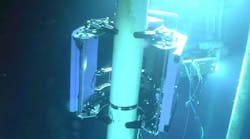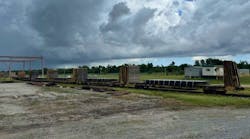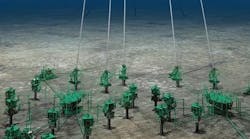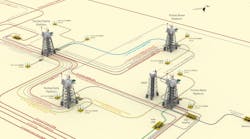Offshore's Editorial Advisory Board members are projecting tempered oil prices for 2001 (although possibly not the same for gas) and a continued push into greater water depths and spreading gas exploration in deep sediments as long as product prices hold.
As a result, the two toughest requirements will be dealing with the limited supply of experienced professionals, which could become a serious crisis if the industry expands any faster than it is now, and managing the growing risks associated with drilling ($20-40 million per well) and development ($500 million plus) in deepwater. Other factors pointed out by board members include the following:
- Exposed inefficiencies: Greater expenditures in deepwater mean the industry can no longer hide inefficient functions.
- R&D compensation: There must be a better way to compensate service companies who are shouldering the R&D function.
- Geoscience integration: Geophysical companies gradually are becoming the exploration arms of producing companies by virtue of the "just-in-time" nature of the business.
- E-business: Any sort of e-business shortcuts available for E&P operations must be directly linked to the bottom line.
- Development verification: As the risks rise in deepwater development, producers are putting more pressure on designers, certification, and classification agents to lower risks.
More detail on these key points in Forecast 2001 are available in the following board members' statements.
Back to the E&P basics
P. Michael Harris
Apache Corporation
As the world changes around us, or as we change the world, some things have remained the same. These are the prin-ciples that drive our industry. Production of hydrocarbons is a commodity business. The company that explores, acquires, develops, and produces oil and gas at the lowest price has a distinct advantage over competitors.
Drilling and completing wells is a necessary component, and a significant cost factor, in the process of producing hydrocarbons. Factors that have worked against the efficiency in drilling and completions include product price cycling, single year budgeting, and the working of joint partnerships.
Factors that indisputably contribute to success in drilling and completing wells in the most economic way include:
- People: Having the right number of properly trained and qualified people included in the processes
- Project management: Proper planning and learning over the life cycle of the well
- Technology: Identification and application of appropriate technology
- Supply chain management: Optimal utilization of the suppliers in the processes.
- Continuity of operations: Utilizing the same equipment and people in a series of operations.
The industry has identified significant pitfalls for the near future. There is a shortage of qualified, trained personnel right now; that will only get worse as demographics change with time. The majority of drilling (and oil and gas) professionals are single digit years from retirement age. This year, there are only 320 people in US universities graduating in petroleum engineering. The industry will definitely suffer from a people shortage for the foreseeable future.
There have been major upsets in supplier/ operator relationships, recognizing that at the best of times there exists a conflict in those companies' respective goals. Also, drilling and completing of oil wells contradict the normal volume/price relationship: the more wells the industry drills in a year, the higher the unit costs are.
At many recent industry forums, I have noted that suppliers are exclaiming that the recent rise in oil and gas prices has not translated into respective increases in the prices of their products and services. Concurrently, there have been significant failings of the supply chain to recognize that the train is beginning to come off its tracks.
Specifically, as pointed out by a panel in this year's International Association of Drilling Contractors annual meeting, the delay of completion and lack of operability of many of the new and rebuilt offshore rigs were identified by individuals within companies all along the supply chain. But the impact on operators' objectives was not acknowledged by the companies - neither supplier nor user - until after the problems were manifest and significant.
There are deepwater rigs that have accumulated downtime exceeding one-half the total rig time. We need to focus on value in the supply chain and reward or be rewarded accordingly. The price of our end product may mask inefficiencies today, but may kill a project in the near future. I contend that many deep-water projects that are being undertaken now will not survive even a short period of low oil and gas prices.
Technology has been a leading factor in lowering costs of well construction and production. Technology developments have increased our exploration success, allowed us to drill faster, complete more efficiently, more effectively drain reservoirs, and drill in more hostile environments. The technology of production in deepwater has fallen behind drilling, with several notable failures in delivery and/or completion efficiency in the deepwater Gulf of Mexico.
We cannot afford to develop technologies that do not timely nor effectively impact the bottom line. There has been much publicity associated with "e" technology - e-commerce, business to business transactions, visualization technology - but there have been fewer success stories in the E&P business than one would expect. Perhaps, like deepwater production, we have been slow to catch up with leading technology, or have been slow to change our work processes to take advantage of electronic capabilities. I haven't seen practical solutions to the problems and opportunities cited above. As an example, I would like to point out that Apache has led the industry in successfully managing the factors that work against the industry.
We have cut back in high cost environments and taken advantage of the opportunities in times of low prices. This strategy is only attainable for the brave, who can show their shareholders that strong earnings and growth can mutually exist over a long period in this scenario. We have a culture that rewards the efforts of our people and have one of the leanest organizations in our sector.
We have carefully and effectively adapted and applied technology in exploration, development, and production. Apache has anticipated, prepared for, and reacted to changes in the business environment in a way that has resulted in our first quarter earnings per share practically matching the combined earnings-per-share of three significant players in our peer group.
Mike Harris is Director of Worldwide Drilling for Apache Corporation. He began his career with Exxon in engineering research, in the area of chemicals followed by drilling fluids and systems. He held various drilling management positions with Amoco, including Drilling Manager of the Netherlands, UK and the US, and was Regional Drilling Manager for BP Amoco prior to joining Apache. He holds a BS in Chemical Engineering from the University of Arkansas.
Deepwater pursuit reflects fundamentals
Robert Campbell
Noble Drilling Corporation
This time, one short year ago, we in the offshore industry, like all industries world-wide, anxiously awaited the impending Y2K event. A global preoccupation with the uncer-tainties reigned, and predictions of dire cons-equences were in no short supply.
Today (at the time this is written), the undecided presidential election in the world's sole superpower creates its own measure of global preoccupation with uncertainty. Tomorrow and looking forward to 2001, uncertainty and change will certainly be no strangers for the offshore industry, and more specifically, for the contract drilling sector.
I admit to harboring some reservations about writing an outlook commentary, being mindful that only hindsight (not foresight) is 20/20. The precipitous drop in drilling activity that followed the commodity price decline in 1997-98 was largely unforeseen before its reality was experienced, and offshore drilling contractors are just now beginning to recover. Nevertheless, certain outlook trends, technologies, and events, while not susceptible of absolute certainty, merit venturing a comment.
The trend toward ultra-deepwater exploration, development, and production will continue into 2001. Oil company capital investments in deepwater leases and their successes in deepwater exploration have set the stage for further explor-atory drilling as well as increased levels of developmental drilling. Virtually all the deepwater drilling units built or converted during the recent construction cycle have been delivered or are nearing completion. The softness in the ultra-deepwater market earlier this year has firmed somewhat, and I believe the market for the limited number of units capable of drilling in greater than 5,000 ft water depth will get tighter in 2001.
Drilling contractors demonstrated greater discipline in rig construction and conversion in the 1996-99 period than in the speculative building boom of the late 1970s and early 1980s. Excess capacity of drilling units plagued the sector throughout the balance of the 1980s into the mid-1990s. As many drilling contractors generate and look forward to further solid financial performance, we would be well advised indeed to recall our history and demonstrate appropriate financial discipline.
Crude oil prices above $30/bbl and US natural gas prices above $5/MMBtu are telling us that supply is not keeping up with demand. Prices at these levels are causing decisions to be made to attempt to lessen the tightness in the market. Furthermore, commodity prices cannot be sustained at current levels without adversely impacting segments of the global economy, which would then serve to dampen demand. It would be unwise to rely on US natural gas prices at current levels. However, assuming they remain reasonably robust, premium jackup drilling rig activity in the Gulf of Mexico will stay high, and, therefore, an operator's access to premium jackup rigs will be crucial to its success.
Although the price of gas will likely remain volatile, longer-term it will continue moving upward, buoyed by rising demand and rapid depletion of existing reservoirs. While we must cope with the consumers' cynical view of the energy industry's desire for lower prices, a moderation in oil prices to the mid-$20s, and in gas prices to about $4, would benefit not only those who consume energy but also those engaged in its creation.
Advancements in technology will accelerate to enable safer and more efficient drilling operations. Communications between offshore units and shore bases or headquarters' offices, and the costs of such communication continue to improve. I expect we'll witness quantum leap enhancements in 2001 in the transmission of real-time drilling data from offshore units to onshore offices.
The down cycles in the industry, which result in lower drilling activity levels, invariably cause a reduction in the number of offshore oilfield workers. Prolonged periods of lower drilling activity tend to cause these personnel reductions to become permanent, with the associated drain in human capital experience. As drilling activity levels improve, new and inexperienced crewmembers must be recruited and trained. Achievement of an adequate supply/demand balance for crews in a rising market creates upward pressure on labor costs, which has occurred to date and can be expected to continue into 2001.
The offshore drilling industry has taken substantial strides in recent years to improve both the protection of our people and the environment. A step change in safety was warranted in the face of the perception that the industry's safety commitment and performance had stalled out on a plateau.
Insistence on a zero-accident culture and commitment to proactive safety leadership training start at the head of the organization. Implementa-tion in the field takes teamwork and cooperation among everyone - operators, drilling contractors, and other service companies. As an industry, we must continue our investments in leading-edge technologies designed to reduce emissions and improve environmental quality. These efforts in 2001 and beyond are essential for the health and welfare of our people, and the reputation of our industry.
Through focused research, planning, preparation, and corrective action, the uncertainties and potential crises surrounding the Y2K event were avoided and substituted with New Year's Day parades, football, and family gatherings. We look forward to 2001 with anticipation that this same kind of planning and preparation will equip the industry for the inevitable unforeseen events. Our challenge will be to anticipate and embrace change and resist the tendency to allow uncertainty to paralyze positive action.
Robert D. Campbell is the President of Noble Drilling Corporation. Previously, he practiced corporate/securities law as a senior partner with Thompson & Knight L.L.P. and was Noble Drilling's general counsel for more than five years. He holds a BS in Chemical Engineering and a JD in law from The University of Texas at Austin.
Changing role of seismic contractors
Stephen J. Ludlow
Veritas DGC Inc.
Last year's editorial comment from the seismic sector said "the current economic climate, with improving financial gains for the oil companies, had not been translated into E&P budgets capable of supporting a healthy service industry." Twelve months later, little has changed. Geophysical contractors are now being forced to evaluate and redefine their business models to ensure survival.
The business of supplying seismic services and information is a capital-intensive one, utilizing limited-use hardware. Virtually everything the contractor invests in has a sole use and purpose - to collect and process seismic data. The proprietary service business typically provides inadequate return on investment in a "good" climate, while negative cash flows are common as contractors attempt to maintain utilization of people and equipment in a "bad" climate.
In recent years, the multiclient/data library model has enabled industry to better plan the utilization of resources and help to manage investment decisions. As a result, data ownership now resides with the contractor. This data is licensed to the E&P industry, often multiple times. Although this has not been a perfect business model, it is a better business than proprietary work with low returns and no upside. It has, however, altered the business model that was the industry standard for many years.
Our industry has more than $10 billion invested in current data library assets, according to the International Association of Geophysical Contractors survey of October 1999. It is estimated that more than $1 billion is being invested in library data this year. These investments are being made with little or no involvement from our E&P customers in the form of financial risk sharing. This means that the exploration risk - when it comes to seismic data, arguably the most important exploration tool available - now resides firmly on the contractors' balance sheet.
A "just in time" seismic data supply business has been created. This means that in many cases, the exploration cycle time, as we knew it, has been significantly reduced. The downside of this, and probably the primary reason that new seismic spending has been slow to materialize, is the creation of a "data supply bubble."
There is little doubt that technology such as multi-component recording, processing, and interpretation will become another added value tool for explorationists to use. There will also be high-end seismic used for reservoir and production monitoring information. However, implementation of this technology will require another round of significant capital expenditures. A profitable market must be available to justify these investments.
As the operational risk and financial burden of supplying seismic information is increasingly borne by the contractors, it is only natural that we will see further movement when it comes to the application of knowledge. Geophysical contractors are beginning to apply much of the knowledge long associated with E&P companies and are now providing prospecting and reservoir management solutions.
Is there a market for these advanced solutions, traditionally the realm of E&P? Over the years, many disciplines have passed from the oil companies' portfolios to become contract services. Geophysical service providers are becoming a valid employment alternative for many highly trained E&P specialists disenchanted with the career opportunities with E&P players. This is not to suggest that the seismic companies will become E&P companies. It is unlikely that they will take acreage positions, and they will not drill wells. Instead, they will seek risk/reward based cash payments, as opposed to equity ownership.
Geophysical contractors are rapidly creating an environment of credibility as explorationists. Many of our customers are actively embracing the outsourcing of this expertise, a logical extension of the contractors' portfolio, particularly in light of the risk component already carried on their balance sheets.
Looking forward, our biggest challenge will be receiving a fair share of the value we create. If we are to be compensated for the provision of solutions, then an appropriate portfolio of risk must be established and integrated with the E&P business model. Proprietary acquisition and processing will always be available, given sufficient return on investment.
The supply of data library information for interpretation by E&P companies will continue as a component of our business. A supply of prospects, drilling locations, and reservoir solutions is now being made available on an outsource basis. Our industry, the geophysical service and supply business, is becoming an information and solutions based business. Managing and sharing in the risk, both high and low, will help bring us closer to the financial stability needed to ensure the future and continued evolution of the seismic business.
Stephen Ludlow is Vice-Chairman of Veritas DGC Inc., where he held the position of President and Chief Operating Officer for three years after the Veritas-Digicon merger in 1996. Prior to that, he was employed by Digicon for 24 years, serving as President and Chief Executive Officer for two years and Executive Vice-President for four years. Ludlow held a variety of management positions with Digicon, including several years in charge of operations for Europe, Africa, and the Middle East. This year, he serves as President of the International Association of Geophysical Contractors (IAGC).
Embracing knowledge engineering
Dr. B.P. Malcolm Sharples
ABS
The offshore industry is about to tackle the most challenging and exciting period of its 50-plus year history. Drilling in deepwater has necessitated change of exponential proportions in the last five years in terms of automated drilling systems and the complexity of the vessels upon which drilling and production is now based.
These complexities, together with a migration from regulatory concern over component reliability to concern about system reliability, have caused significant changes in the emphasis and methods with which we do business. The cost involved in terms of downtime risk is causing all links of the supply chain to look at how to do business in a more reliable and cost-effective way: services, prioritized by their value, delivered to the customer electronically, globally, and with ever-increasing speed.
For classification societies, these changes mean managing physical risks to the facility more effectively, prioritizing the resources and requirements to match the risks, and delivering the information on service results in an electronic and immediate format.
Several examples can be cited of leading technology innovations in the regulatory and owner-compliance arena. For shipshape vessels, such as FPSOs and drillships, simplifying the complexity has dictated development of structural design tools that carry out automatic code checking. For machinery and process, systems are now available to track equipment reliability in some detail and in concert with maintenance programs. This innovation will change the face of regulatory requirements in the future from the periodic survey and compliance with prescriptive regulation to allow for purpose-built (bespoke) systems that meet a risk-based criteria both for design and inspection (RBI or risk-based inspection).
Ongoing survey requirements are likely to evolve using client data on reliability of structure and equipment as the industry moves toward reliability-centered maintenance. A critical issue here for the offshore business is to avoid downtime. Resources can be focused where they can do the most good. Component checking is giving way to systems checks in the regulatory arena. The method will be appropriate performance standards in concert with risk analysis tools.
Another innovation, which will lead to streamlining the process, is the advance in 3D visualization tools. Concurrent design and regulatory checking using such tools, with the addition of human factor checks, will allow an integrated approach and optimize time for getting the design into the construction phase. For ABS and its affiliated companies, it has meant offering value-added services to owners and operators as an addendum to the traditional service role.
Asset integrity management is the buzzword that the industry has adopted for managing the near-infinite amount of interrelated data generated during design, construction, and operations of increasingly complex structures and equipment. It is the central core of what is required to manage the risks to personnel, property and the environment - the class traditional role - but can also be tailored to manage the asset effectively during its life cycle.
Data, thus assembled and maintained, can be used to assure regulatory compliance and can also be used for compliance with owner and operator requirements. Communications and technology have advanced us to the point where this kind of information is now expected to be available globally at a moment's notice. IT systems have evolved to the point where ABS has made the investment to expand the survey reporting system to be able to include many of the facets of asset integrity management. Doing more with less is doable provided suitable electronic systems are available for tying information together for effective data management.
We have lived with the paradigm of doing more with less, and lately with the concept of doing more with the least amount imaginable. Like it or not, it appears to be the way of the future. Technology can help us to do that with confidence and surety. As we progress toward that goal, "knowledge engineering" will become an important commodity.
Even today, as we ramp up for another up-cycle, there is a growing shortage of experienced engineers in the offshore business. Even though the offshore business is a global provider of energy with a demand for a constant infusion of experienced naval architects, marine engineers, process designers, subsea engineers etc., they are all in short supply. History has shown that with the cyclic nature of our business, it is unlikely to be a problem that solves itself. What is the solution to this? The philosophical gurus keep telling us that those who don't know history are destined to repeat it, and to many of the engineers in our business, examples like the "Alexander Kielland" and the "Ocean Ranger" are distant history, if their names are recognized at all. Our only solution is to record the knowledge in some way and link lessons learned to the performance standards.
This so-called "knowledge engineering" is in its infancy, but it will become progressively important as computer systems learn from the experienced practitioner, and in turn, assist the future less-experienced engineer in understanding the appropriateness of requirements. Some fascinating research programs are currently going on that will help us design and put these systems together for our respective parts of the business.
Technology advances are making us better able to do a competent job. As an industry we can now leverage our knowledge base and risk analysis capabilities together with risk-based systems design to make a significant impact in reducing the probability of accidents. We have here the potential for affecting life property and the natural environment while avoiding production downtime. Importantly, we have the opportunity to bring increased design flexibility for deepwater applications.
Dr. Malcolm Sharples is Vice-President of Offshore Project Development for the American Bureau of Shipping (ABS). He heads an organization charged with business development of offshore projects and the coordination services from ABS Bureau and ABS Group Companies. He holds a BS in Engineering Science from the University of Western Ontario and a Ph.D. in Structural Engineering from Cambridge University. Prior to joining ABS, he was President of Noble Denton and Associates Inc., an offshore surveying firm.
Learning from the cycles
Lars Felix
GVA Consultants AB
During recent years many companies in the offshore industry have struggled due to very limited work. The dip in the oil price by about 50% within the last few years and the uncertainty in forecasting a future price level created an uncertainty over the future develop-ment of the offshore business.
Mergers and acquisitions among oil companies and drilling operators have taken the focus away from the development of oil fields and drilling units. As a result, many design and engineering companies have suffered and been forced to go through restructuring phases. This has resulted in experienced staff in some companies leaving the offshore business for other sectors.
For GVA Consultants AB, a design company for floating offshore structures with a staff engaged in offshore technology since the end of the 1970s, it is now a pleasure to note that we have again come through such an uncreative period and that the number of opportunities are rising. What have we learned from the latest cycle? What can be done to ensure that good quality products are delivered as a result of development work? How can we mitigate future market fluctuations?
The semisubmersible has become established as a platform for production facilities. We have delivered semisubmersible concepts for new production units, followed by engineering and supervision throughout construction and installation for three field developments in the North Sea during the last five years. This has added significant knowledge to existing experience acquired through our previous designs.
Over the last five years, we have seen a preference for semisubmersibles in field developments both as platforms for production facilities and including drilling facilities where semis are applicable. Also, we have learned that the semi can be used for dry tree solutions. In this area, further development is ongoing. Petrobras in Brazil has, for many years, been a frontrunner in the use of semisubmersibles as production platforms and has extensive experience in operating these units.
In the North Sea, the semi concept has been established over the last decade, and its use will continue. For the Gulf of Mexico, the benefits of the semi concept are now also being recognized, and it is being considered as a preferred alternative in a number of field developments as a production facility carrier. We believe that oil companies, acting in other geographical areas, will follow these developments closely and also have the semi-alternative evaluated for their field developments.
The conversion of semisubmersibles for drilling has on several occasions ended up offering unacceptable costs and overruns on scheduled delivery times. There are, of course, many reasons for this, but we believe such issues can be avoided. We have noted that there are existing drilling semis feasible for conversions for deepwater drilling. There is a demand for deepwater drilling units, which can be met in the short-term by additional conversions. There are also a number of units appropriate for conversion to drilling and/or production units for marginal fields. We believe that market demand will create opportunities for a number of these units to be developed. Design companies should develop and offer well-defined concept solutions including prefabrication of parts to limit the time that the semi is out of operation.
GVA Consultants has participated in conversions delivered as planned and, based on that experience, has developed a concept for the conversion of drilling units. For conversion of drilling and/or production units, another add-on concept, has been developed. The main advantage with these types of concepts is the ability to prefabricate new parts with minimal interference to the existing units, resulting in reduced out-of-operation time at the shipyard.
We now also note that interest in newly-built semisubmersible drilling units has returned. In the near future, newbuild drilling units for deepwater will be needed. Like all designers, we are looking forward to developing semisubmersible units to match the latest developments in drilling technique.
The oil price has now been at a high level for a relatively long period. We all know that there will be ongoing fluctuations in oil prices, but our vision as designers is that oil companies should be able to act more on a long-term basis, and drilling contractors will be able to sign long-term contracts. This will facilitate further and deeper technical R&D, including the ability to maintain sufficient staff experienced in offshore technology. The result will be advanced offshore structures for production and drilling and an environment that encourages all parties to consider the technical, economical, and environmental aspects of our work.
Lars G. Felix is Managing Director of GVA Consultants AB, a member of the BMT group of companies. After obtaining his MS in Engin-eering and Naval Architec-ture from Chalmers University of Technology, he served as naval architect in a consultancy. He began his career in the offshore sector at G







